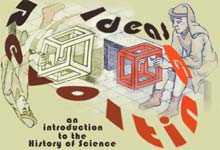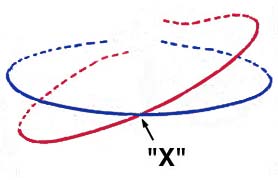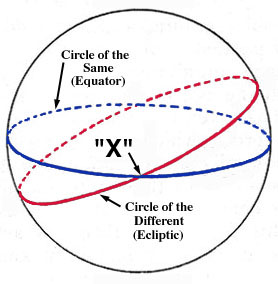
University of California, Irvine
Instructor: Dr. Barbara J. Becker

|
Week 1. Likely Stories excerpts from
|
The shape he gave it was suitable to its nature. A suitable shape for a living being that was to contain within itself all living beings would be a figure that contains all possible figures within itself. Therefore he turned it into a rounded spherical shape, with the extremes equidistant in all directions from the center, a figure that has the greatest degree of completeness and uniformity, as he judged uniformity to be incalculably superior to its opposite. And he gave it a perfectly smooth external finish all around, for many reasons....
Of the seven physical motions [up, down, backwards, forwards, right, left, uniform circular motion in same place] he allotted to it the one which most properly belongs to intelligence and reason, and made it move with a uniform circular motion on the same spot; any deviation into movement of the other six kinds he entirely precluded....
 The Craftsman arranges the fabric of the universe.
The Craftsman arranges the fabric of the universe. |
|
He then took the whole fabric and cut it down the middle into two strips, which he placed crosswise at their middle points to form a shape like the letter X; he then bent the ends around in a circle and fastened them to each other opposite the point at which the strips crossed, to make two circles, one inner and one outer. And he endowed them with uniform motion in the same place, and named the movement of the outer circle [the celestial equator] after the nature of the Same, of the inner [the ecliptic] after the nature of the Different. The circle of the Same he caused to revolve from left to right, and the circle of the Different from right to left on an axis inclined to it; and made the master revolution that of the Same. He left the circle of the Same whole and undivided, but slit the inner circle six times to make seven unequal circles, whose intervals were double or triple, three of each; and he made these circles revolve in contrary senses relative to each other, three of them at a similar speed, and four at speeds different from each other and from that of the first three but related proportionately....

The structure of the Craftsman's universe. |
|
Time came into being with the heavens in order that, having come into being together, they should also be dissolved together if ever they are dissolved; and it was made as like as possible to eternity, which was its model.... As a result of this plan and purpose..., the sun and moon and the five planets as they are called came into being to define and preserve the measures of time.
And when he had made a physical body for each of them, the craftsman set the seven of them in the seven orbits of the circle of the Different. The moon he set in the orbit nearest the earth, the sun in the next and the morning star and the one called sacred to Hermes in orbits which they complete in the same time as the sun does his, but with a power of motion in a contrary sense to him.... For the rest, if one were to describe in detail where they were set and for what reasons, it would involve more attention to a side issue than is justified....
Anyhow, when the beings jointly needed for the production of time had been given their appropriate motion and had become living creatures with their bodies bound by the ties of soul, they started to move with the motion of the Different, which traverses that of the Same obliquely and is subject to it, some in larger circles, some in smaller, those with the smaller circles moving faster, those with the larger moving more slowly....
And in the second of the orbits from the earth the craftsman lit a light, which we now call the sun, to provide a clear measure of the relative speeds of the eight revolutions, to shine throughout the whole heaven, and to enable the appropriate living creatures to gain a knowledge of number from the uniform movements of the Same. In this way and for this reason there came into being night and day, the period of the single and most intelligent of revolutions; the month, complete when the moon has been around her orbit and caught up the sun again; the year, complete when the sun has been around his orbit.
Only a very few men are aware of the periods of the others; they have no name for them and do not calculate their mathematical relationships. They are indeed virtually unaware that their wandering movements are time at all, so bewildering are they in number and so amazing in intricacy. None the less it is perfectly possible to perceive that the perfect temporal number and the perfect year are complete when all eight orbits have reached their total of revolutions relative to each other, measured by the regularly moving orbit of the Same....
The craftsman turned again to the same bowl in which he had mixed the soul of the universe and poured into it what was left of the former ingredients, mixing them in much the same fashion as before, only not quite so pure, but in a second and third degree. And when he had compounded the whole, he divided it up into as many souls as there are stars, and allotted each soul to a star. And mounting them on their stars, as if on chariots, he showed them the nature of the universe and told them the laws of their destiny. To ensure fair treatment for each at his hands, the first incarnation would be one and the same for all and each would be sown in its appropriate instrument of time and be born as the most god-fearing of living things; and human-kind being of two sexes the better of the two was that which in future would be called man. After this necessary incarnation, their body would be subject to physical gain and loss, and they would all inevitably be endowed with the same faculty of sensation dependent on external stimulation, as well as with desire and its mixture of pain and pleasure, and fear and anger with the accompanying feelings and their opposites; mastery of these would lead to a good life, subjection to them to a wicked life. And anyone who lived well for his appointed time would return home to his native star and live an appropriately happy life; but anyone who failed to do so would be changed into a woman at his second birth. And if he still did not refrain from wrong, he would be changed into some animal suitable to his particular kind of wrongdoing.....
|